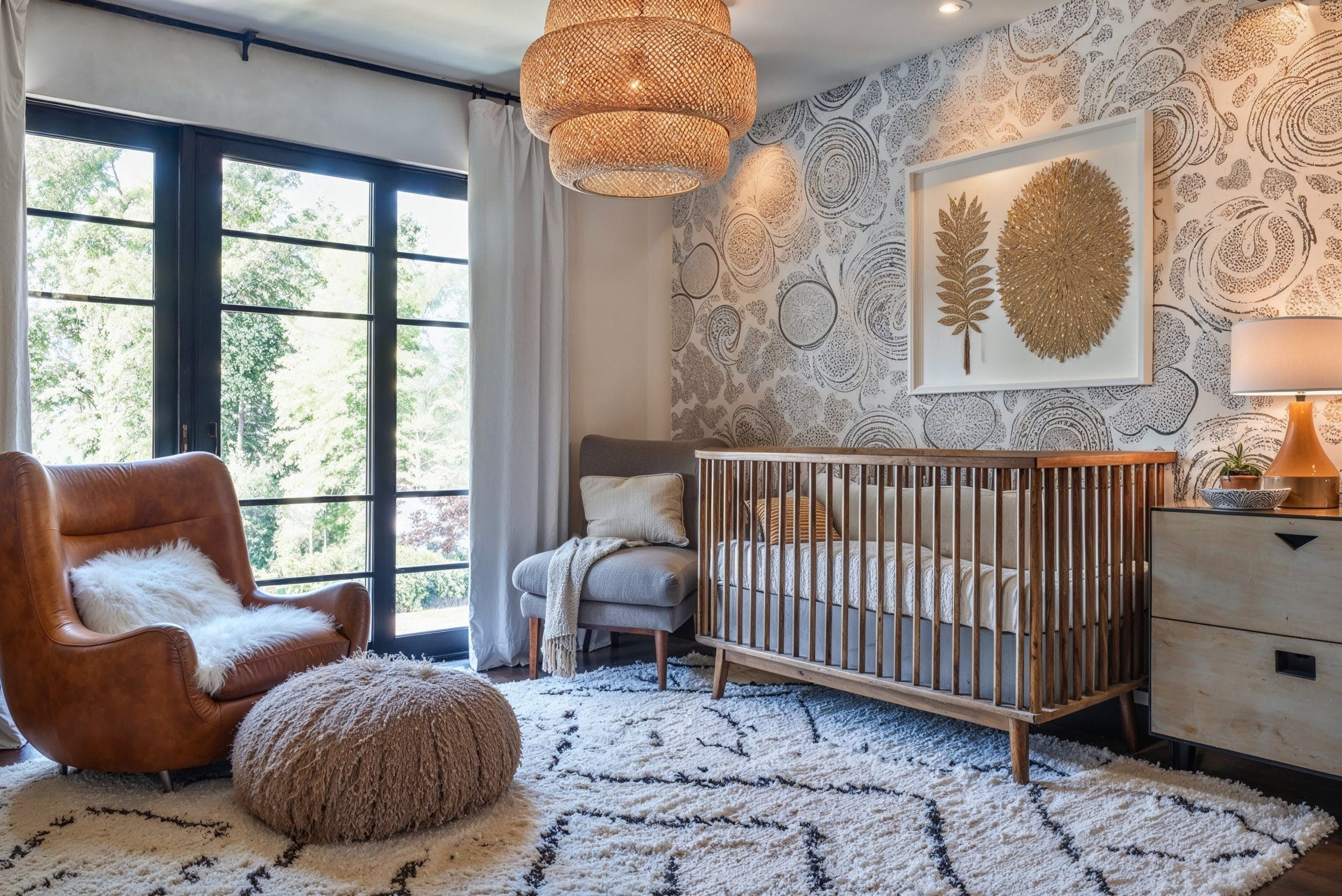Designing your baby’s nursery is one of the most joyful parts of preparing for your little one’s arrival. While traditional nurseries have their charm, eclectic nurseries offer a unique blend of styles, colors, and textures that grow with your child and reflect your personality.
These versatile spaces combine unexpected elements, creating rooms that stimulate your baby’s developing senses while maintaining a cohesive aesthetic.
The juxtaposition of vintage finds with modern pieces, bold patterns with subtle textures, and whimsical touches with practical features results in a nursery that feels both thoughtfully curated and effortlessly cool.
The beauty of eclectic design lies in its flexibility—there are no rigid rules to follow, just guidelines to help you create a space that feels harmonious despite its diverse influences.
Eclectic Baby Nursery Ideas
Whether you’re drawn to bohemian elements, midcentury modern furniture, global-inspired textiles, or nature-themed décor, these 14 eclectic nursery ideas will inspire you to create a one-of-a-kind sanctuary for your baby that transcends passing trends.
1. Globally-Inspired Fusion
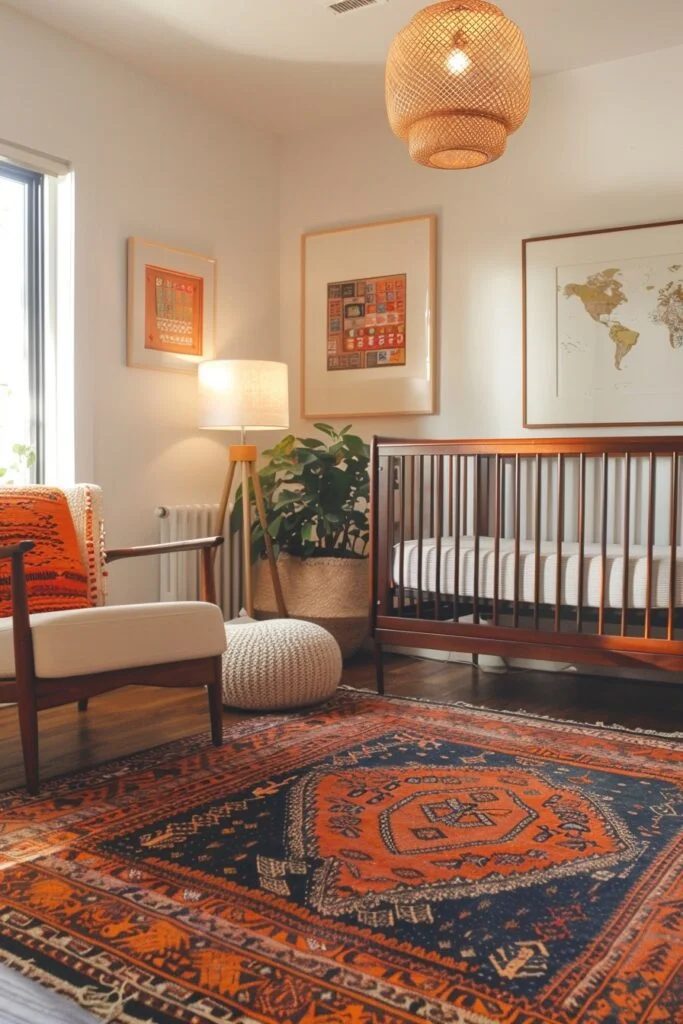
Transform your nursery into a worldly haven by incorporating elements from various cultures. Moroccan poufs, Indian block-printed textiles, African mudcloth pillows, and Japanese-inspired art can create a rich tapestry of global influences that stimulate your baby’s visual development.
This approach not only creates a visually interesting space but also introduces your child to the beauty of cultural diversity from an early age.
Consider adding a vintage Persian rug for warmth, rattan furniture for texture, and handcrafted items that tell stories from around the world. The key is balancing these elements through a consistent color palette that ties everything together harmoniously.
2. Vintage Meets Modern
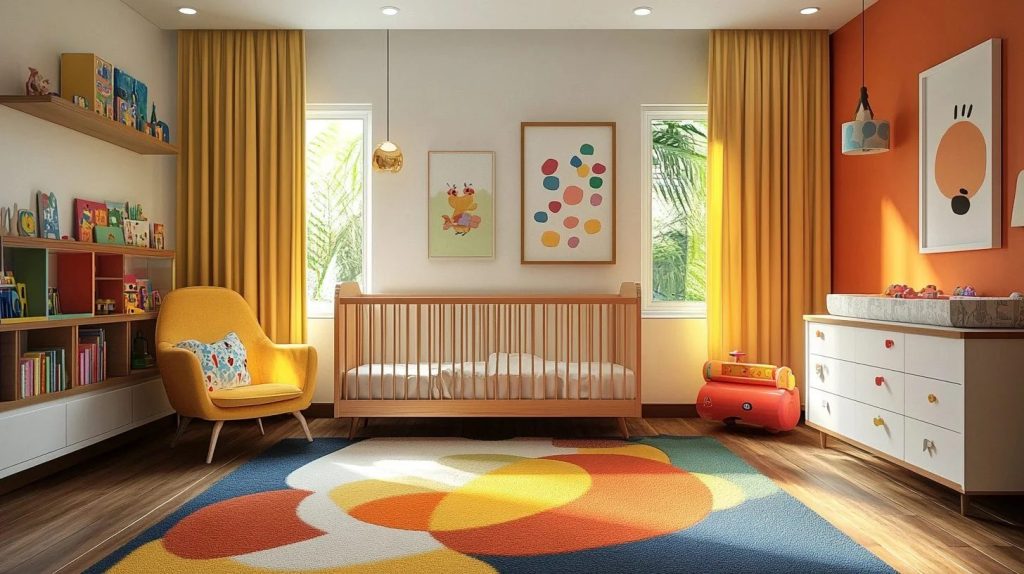
Blend eras by pairing contemporary furniture with carefully selected vintage pieces. A sleek modern crib can be complemented by a restored mid-century dresser repurposed as a changing table, while vintage toys and artwork add character and nostalgia.
This combination creates depth and personality that mass-produced nurseries often lack. Hunt for unique vintage items at flea markets, antique shops, or family attics—perhaps grandmother’s rocking chair or your childhood bookshelf.
Just ensure all vintage items meet current safety standards, particularly with cribs and toys. Fresh paint in contemporary colors can help vintage pieces feel cohesive with newer elements.
3. Nature-Inspired Wonderland
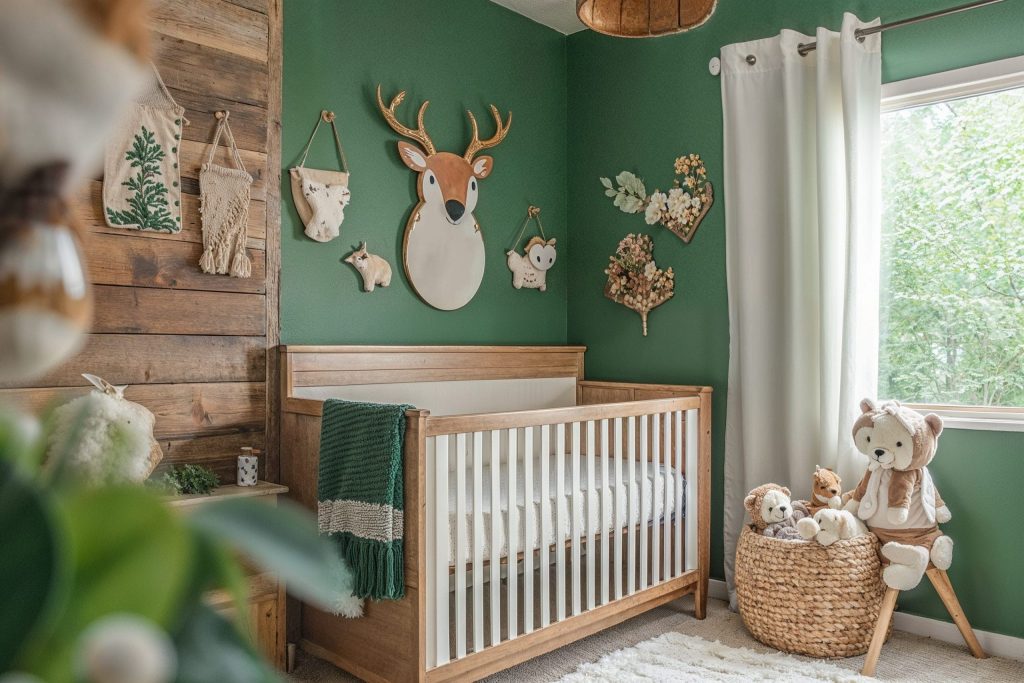
Bring the outdoors in by creating a nursery that celebrates the natural world. Botanical wallpaper, wooden elements in various finishes, plant motifs, and actual child-safe plants create a serene environment connected to nature. This approach works particularly well for families who value sustainability and outdoor experiences.
The natural elements provide endless sensory opportunities as your baby grows. Consider a statement wall with forest wallpaper, furniture in natural woods with minimal finishing, organic cotton textiles, and nature-themed artwork.
Add macramé plant hangers, a wood slice side table, or a bamboo pendant light to enhance the organic feel while maintaining a contemporary edge through clean lines and thoughtful arrangement.
4. Monochrome with Bold Accents
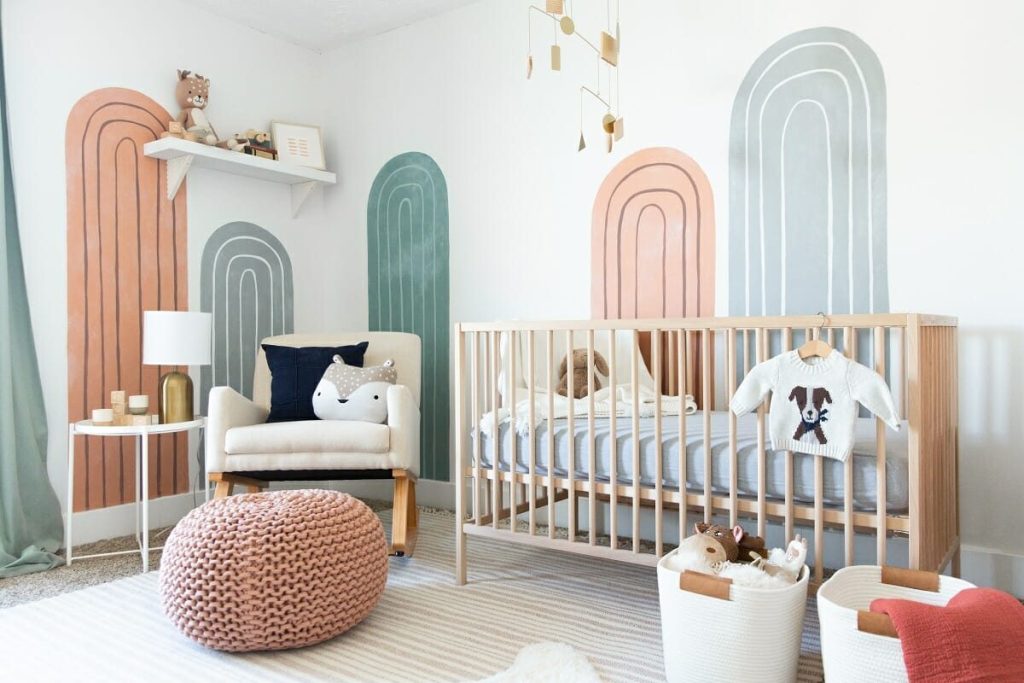
Create a sophisticated nursery with a monochromatic base—black, white, and gray—punctuated by vibrant pops of color. This high-contrast approach is not only visually stimulating for babies but also creates a modern, gallery-like space that’s easy to update as your child grows.
The monochrome foundation provides a timeless canvas that can evolve over the years. Start with white walls and furniture, add black accents through frames and textiles, then introduce bold color through easily changeable elements like throw pillows, artwork, toys, and small furniture pieces.
This approach allows for seasonal refreshes or theme changes without major renovations, making it both practical and visually striking.
Related Guide: 12 Innovative Jungle Nursery Ideas
5. Literary Haven
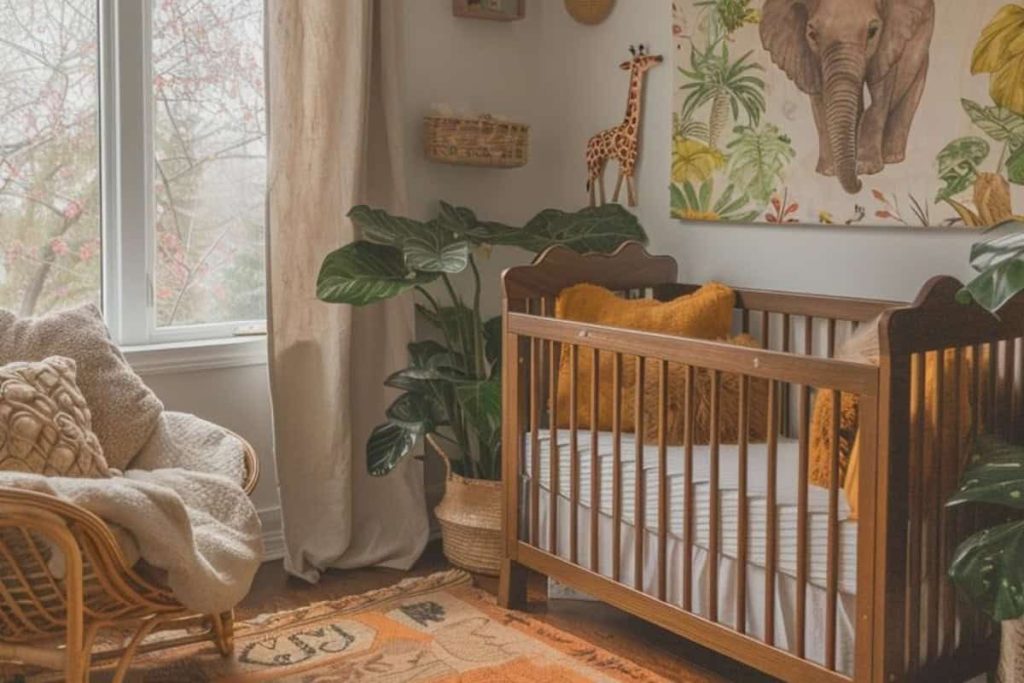
Design a nursery centered around the world of books and storytelling. Floor-to-ceiling bookshelves, comfortable reading nooks, literary quotes on walls, and art inspired by classic children’s books create a space that nurtures imagination from day one.
This theme encourages early literacy while creating a deeply personal environment. Display books with their covers facing outward on front-facing shelves to add color and visual interest.
Add a plush reading chair big enough for cuddling, soft lighting for bedtime stories, and wall decals featuring quotes from beloved children’s books. Mix vintage and contemporary books for visual variety, and consider framed illustrations from classic tales as artwork.
6. Artistic Expression
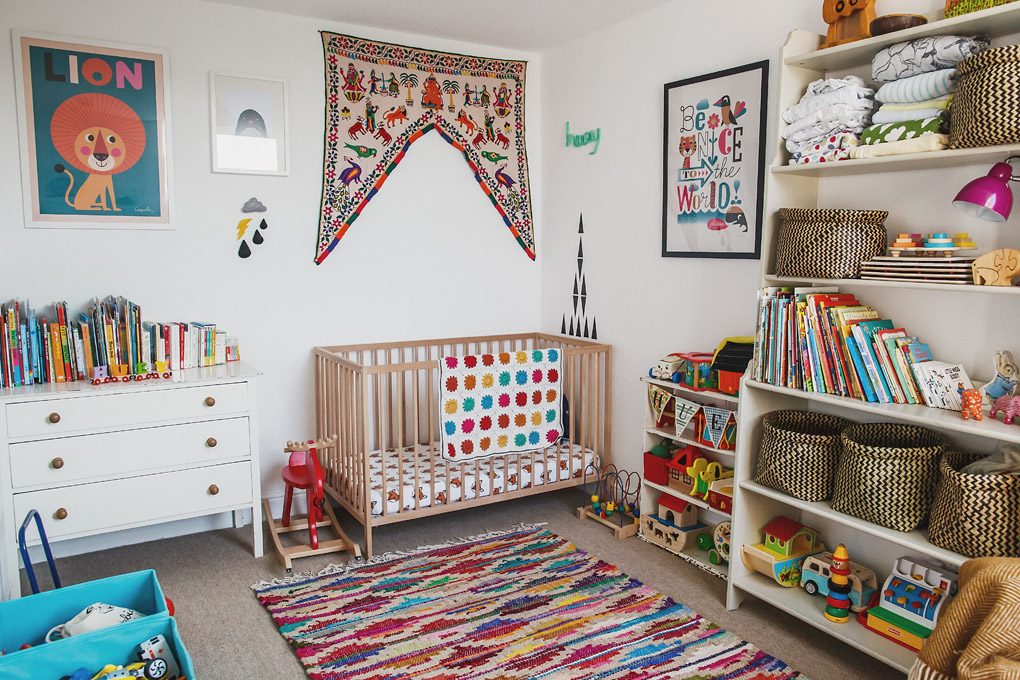
Celebrate creativity by treating your nursery walls as a canvas. Hand-painted murals, abstract art, gallery walls mixing professional and personal artwork, or even framed fabric create a stimulating environment that honors artistic expression.
This approach creates a unique space impossible to replicate. Consider commissioning a local artist for a custom mural, or create your own abstract painting if you’re artistically inclined. Mix framed professional prints with your own creations and family photographs.
Think beyond traditional frames—woven wall hangings, shadow boxes with meaningful objects, or stretched fabric can all serve as wall art. The key is creating visual interest at various heights that will engage your baby from the crib, changing table, and eventually as they begin to crawl and stand.
7. Bohemian Rhapsody
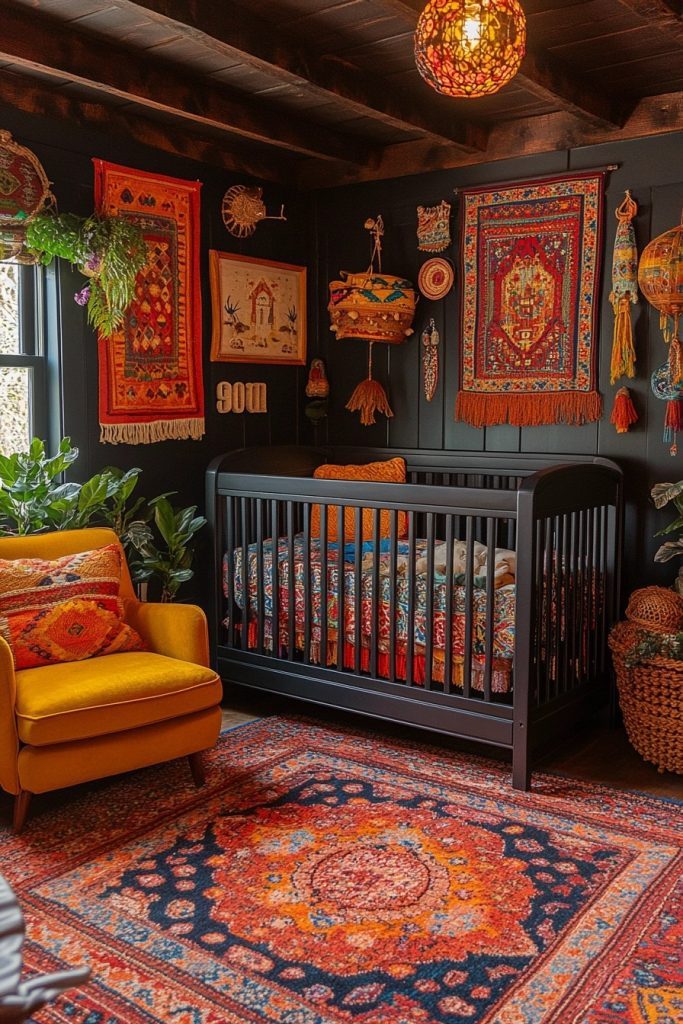
Embrace the free-spirited bohemian aesthetic with layered textiles, mixed patterns, and an earthy color palette. Macramé hangings, floor cushions, Moroccan wedding blankets, and rattan furniture create a relaxed, globally-inspired space perfect for the unconventional family.
This approach creates a cozy, tactile environment rich in sensory experiences. Layer rugs for comfort and visual interest, mix patterns like ikat, suzani, and block prints while maintaining a cohesive color story. Add texture through woven baskets, macramé plant hangers, and tasseled textiles.
Natural materials like rattan, bamboo, and unfinished wood enhance the organic feel. The bohemian style embraces imperfection, making it forgiving for parents creating a space that evolves organically over time.
8. Celestial Dreamscape
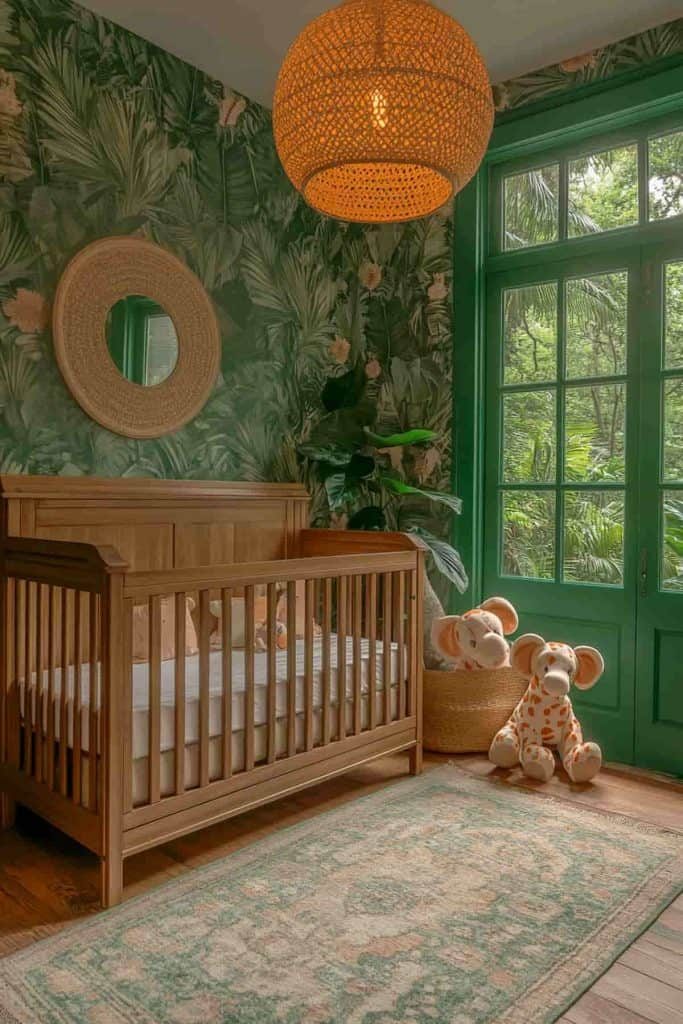
Create a magical atmosphere with a cosmic-inspired nursery theme. Constellation patterns, moon phases, stars, and planets combine scientific interest with dreamy aesthetics that can grow with your child from infancy through the early school years.
This theme balances whimsy with educational value. Consider a deep blue accent wall with metallic star decals, a statement celestial light fixture, or glow-in-the-dark constellation ceiling stickers.
Incorporate astronomical elements through bedding, artwork, and accessories while keeping furniture simple and timeless. This theme works beautifully with metallic accents in gold, silver, or copper that catch the light and create a magical atmosphere perfect for dreaming.
9. Textile Showcase
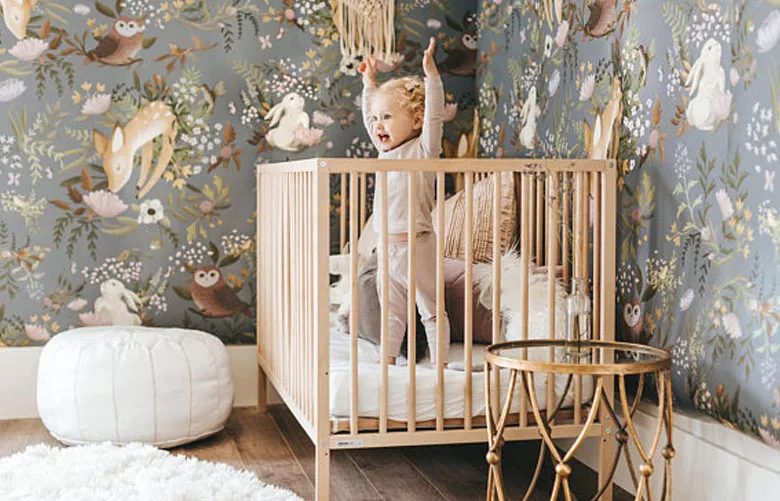
Build your nursery design around striking textiles from around the world. Handwoven blankets, embroidered pillows, quilts, tapestries, and unique window treatments become the stars of the show in this textile-forward approach to nursery design.
This method creates a cozy, layered space rich in tactile interest. Start with a special textile piece—perhaps a handmade family quilt, an heirloom tapestry, or a stunning rug—and build your color palette from there. Layer different textures and patterns while maintaining visual harmony through color consistency.
Display textiles at various heights: rugs underfoot, woven wall hangings at eye level, and perhaps a canopy of fabric above the crib. This approach celebrates craftsmanship while creating a visually rich environment.
10. Minimalist with Character
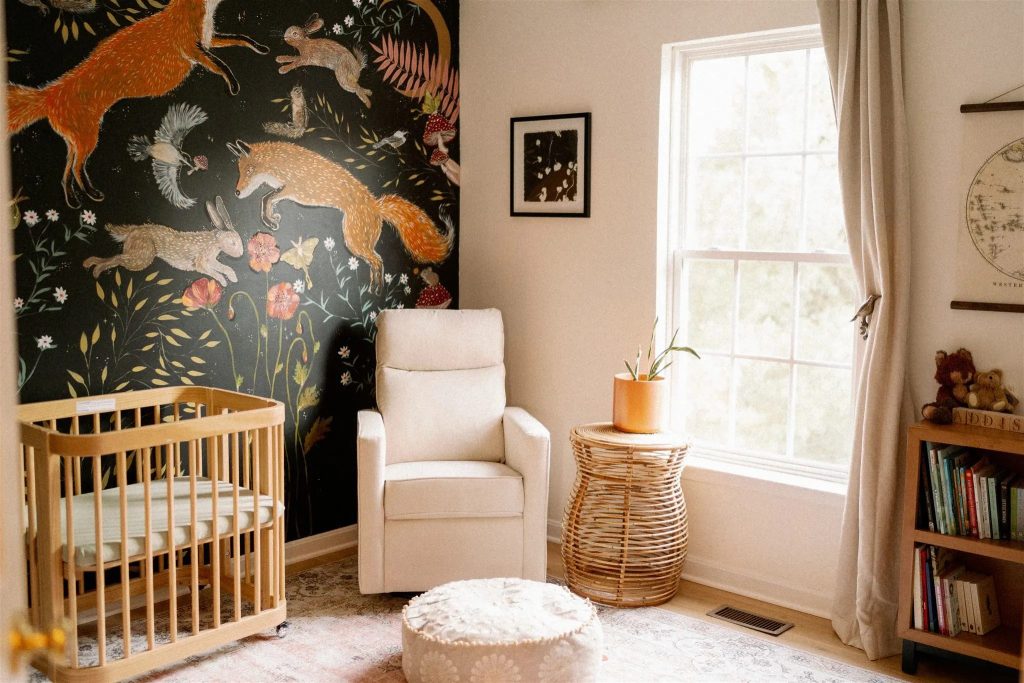
Create a thoughtfully edited space that embraces minimalist principles while maintaining personality. Clean lines, a limited color palette, and carefully selected statement pieces result in a calm, uncluttered environment that still feels warm and inviting.
This approach creates a serene setting that won’t overwhelm your baby’s developing senses. Choose multifunctional furniture with clean lines, limit your color palette to 2-3 hues, and be intentional about every item introduced to the space.
The key difference from pure minimalism is the incorporation of a few carefully chosen character pieces—perhaps a sculptural light fixture, a bold piece of artwork, or an heirloom rocking chair. These elements add soul to the space while maintaining the calming benefits of minimalist design.
Related Guide: 15 Appealing Vintage Baby Boy Nursery Ideas
11. Whimsical Wonderland
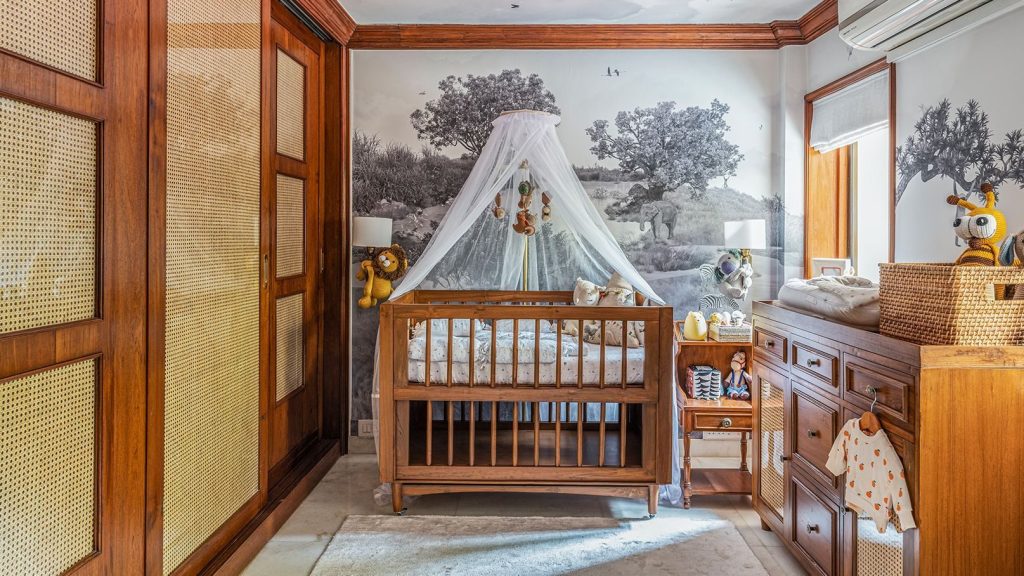
Indulge your playful side with a nursery that celebrates imagination and fantasy. Unexpected color combinations, playful proportions, and elements of surprise create a space that delights both baby and parents. This approach embraces the joy and wonder of childhood while maintaining aesthetic appeal.
This style creates an environment that stimulates creativity and imagination. Mix unexpected colors like coral and mint or purple and mustard, play with scale through oversized artwork or a statement light fixture, and incorporate elements of surprise like a ceiling painted in a bold color or a reading nook hidden behind a curtain.
The key is balancing whimsy with restraint—choose a few standout playful elements rather than filling the space with every cute item you find.
12. Industrial Softened
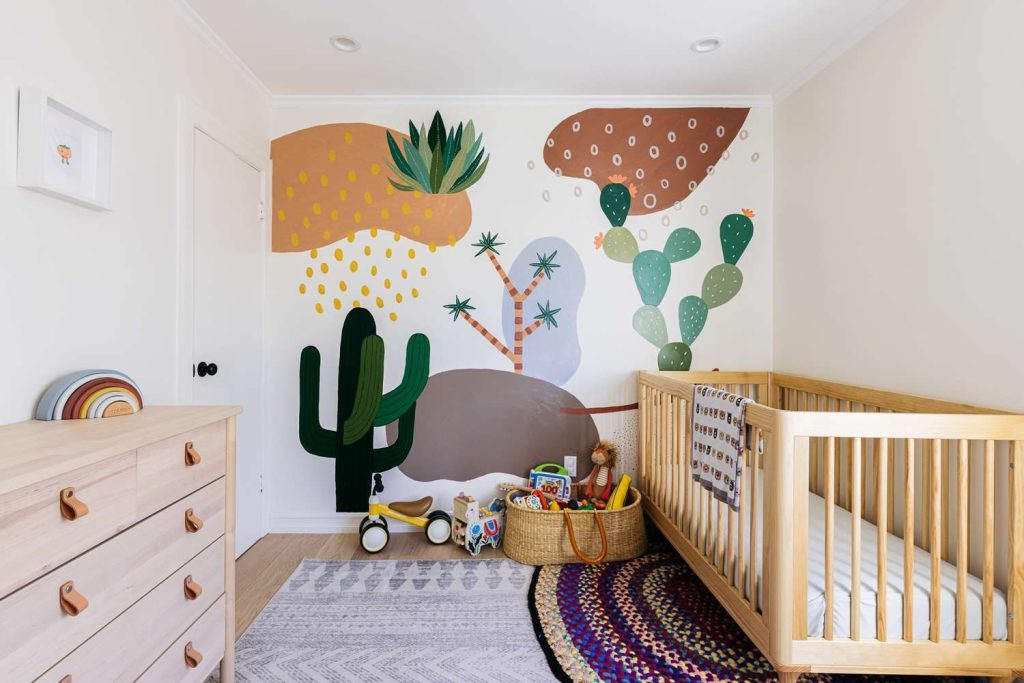
Blend the raw appeal of industrial style with softer elements appropriate for a nursery. Exposed brick or stone (real or faux), metal accents, factory-inspired lighting, and architectural salvage create a sophisticated backdrop when balanced with cozy textiles and playful touches.
This unexpected approach creates a nursery unlike any other. Start with industrial elements like a metal bookshelf, factory-inspired pendant light, or furniture with visible hardware, then soften the look with plush rugs, rounded edges, and tactile fabrics.
The contrast between raw and refined creates visual interest while ensuring the space remains appropriate for a baby. This style works particularly well in urban settings or converted spaces with existing industrial elements.
13. Color Block Drama
Make a bold statement with geometric color blocking on walls, furniture, or textiles. This graphic approach creates visual interest through shape and color rather than themed elements, resulting in a modern, artistic nursery that stimulates visual development.
This design technique creates a contemporary space with enduring appeal. Choose 3-4 complementary colors and apply them in geometric patterns on walls, furniture, or fabric elements.
The shapes can be as simple as rectangles or as complex as abstract forms, depending on your comfort level with paint or wallpaper. Keep other elements relatively simple to let the color blocking take center stage. This approach works well for parents who want a modern aesthetic without cartoon characters or overly childish themes.
14. Curated Eclecticism
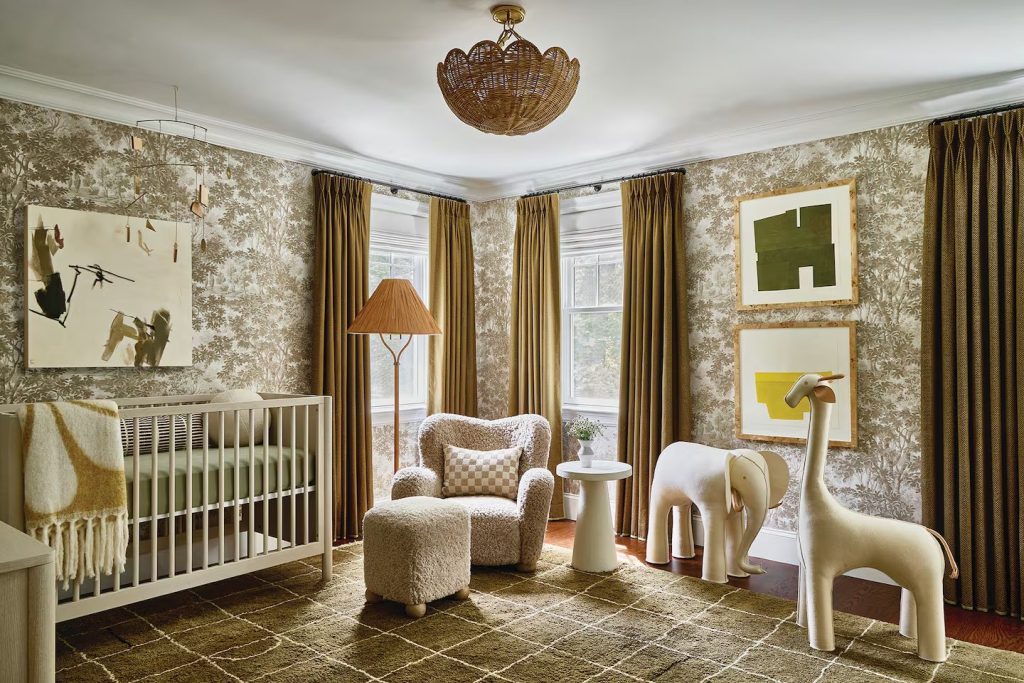
Master the art of thoughtful curation by selecting pieces from various styles that speak to you personally. This approach requires confidence in combining seemingly disparate elements—perhaps an antique crib, midcentury dresser, bohemian textiles, and contemporary lighting—unified through consistent color, scale, or material.
True eclectic style is about creating harmony from diversity. The key is identifying a common thread—be it wood tone, color family, line quality, or overall vibe—that ties diverse pieces together.
This approach creates a deeply personal space impossible to replicate, filled with items chosen for their meaning rather than their adherence to a particular style. The result is a nursery that tells your family’s unique story and evolves organically as your child grows.
Conclusion
Creating an eclectic nursery isn’t about following a formula—it’s about crafting a space that resonates with your family’s personal style while providing a stimulating, comfortable environment for your baby.
The beauty of eclectic design lies in its flexibility and personal nature; it allows you to incorporate meaningful items, experiment with unexpected combinations, and create a space that evolves organically as your child grows.
Whether you’re drawn to global textiles, vintage finds, bold colors, or minimalist aesthetics, the key is maintaining balance and intentionality.
By thoughtfully curating diverse elements that speak to you, you’ll create a nursery that not only looks beautiful but also tells your family’s unique story and provides a rich sensory environment for your child’s earliest experiences. Your eclectic nursery will be a one-of-a-kind space where memories are made and imagination flourishes.

